Baccalauréat
Physique
D & TI
2013
Correction
Bonjour ! Groupe telegram de camerecole, soumettrez-y toutes vos préoccupations. forum telegram
Exercice 1: Mouvements dans les champs de forces
1.1. Champ de pesanteur
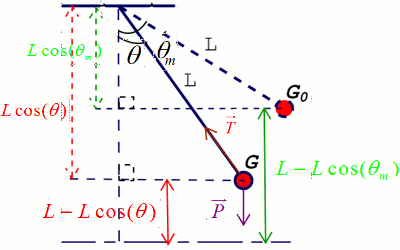
1.1.1 Vitesse du pendule au point G. en utilisant le théorème de l’énergie cinétique, nous avons:
\({E_{{C_G}}} - {E_{{C_0}}}\) \( = W(\overrightarrow P ) + W(\overrightarrow T )\)
\(\frac{1}{2}mv_G^2 - \frac{1}{2}mv_0^2\) \( = - mg({z_G} - {z_{{G_0}}})\) \( = - mg((l - l\cos (\theta ))\) \( - (l - l\cos ({\theta _0})))\) \( = mgl(\cos (\theta ) - \cos ({\theta _0}))\)
\(v_G^2 - v_0^2\) \( = 2gl(\cos (\theta ) - \cos ({\theta _0}))\) \({v_G}\) \( = \sqrt {v_0^2 + 2gl(\cos (\theta ) - \cos ({\theta _0}))} \)
\({\color{blue}{v_G} = 10,23{\rm{m/s}}}\)
1.1.2.a) schéma
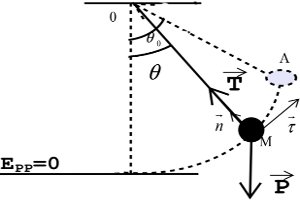 1.1.2.b. Exprimons l’intensité T de la torsion du fil en fonction de v, L, θ, θ 0 ,m et g
1.1.2.b. Exprimons l’intensité T de la torsion du fil en fonction de v, L, θ, θ 0 ,m et gIl est soumis à l’action du poids et à la tension du fil.
Supposons le référentiel d’étude galiléen et appliquons le TCI dans la base de Frenet
\(\overrightarrow P + \overrightarrow T \) \(m\overrightarrow {{a_G}} \Rightarrow \) \(\overrightarrow P {\left( \begin{array}{l} - mg\cos (\theta )\\ - mg\sin (\theta )\end{array} \right)_{\overrightarrow {n,} \overrightarrow \tau }}\) \( + \overrightarrow T {\left( \begin{array}{l}T\\0\end{array} \right)_{_{\overrightarrow {n,} \overrightarrow \tau }}}\) \( = m{\overrightarrow a _G}{\left( \begin{array}{l}\frac{{{v^2}}}{l}\\l\ddot \theta \end{array} \right)_{_{\overrightarrow {n,} \overrightarrow \tau }}}\)
Suivant le vecteur \({\overrightarrow \tau }\) nous avons
\( - mg\cos (\theta ) + T\) \( = m\frac{{{v^2}}}{l}\)
\( \Rightarrow T\) \( = m\frac{{{v^2}}}{l} + mg\cos (\theta ){\rm{ }}\) avec \({v^2} = \) \(v_0^2 + 2gl(\cos (\theta ) - \cos ({\theta _0}))\)
\(T = \) \(m\frac{{v_0^2}}{l}\) \( + mg(3\cos (\theta )\) \( - 2\cos ({\theta _0}))\) \(T = 10,923{\rm{N}}\)
1.2. Champ électrostatique
a) Faisons le schéma montrant le condensateur, la vitesse initiale et les axes du repère choisi.
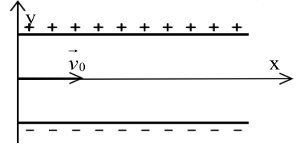 b) L’équation cartésienne de la trajectoire du positron est la suivante
b) L’équation cartésienne de la trajectoire du positron est la suivante\(y = \frac{{e.E}}{{2mv_0^2}}{x^2}.\)
Le positron étant de chaque positive +e
c) Donnons l’allure des deux trajectoires
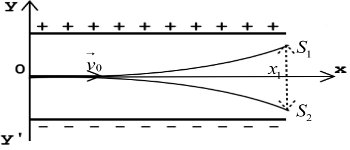
d) Calculons la distance d = S1S2.
\({S_1}\left( \begin{array}{l}{x_1}\\{y_1}\end{array} \right){\rm{ }}\) et \({S_2}\left( \begin{array}{l}{x_1}\\{y_2}\end{array} \right)\) \( \Rightarrow {S_1}{S_2}\) \( = \sqrt {{{({x_1} - {x_1})}^2} + {{({y_1} - {y_2})}^2}} \) \( = \sqrt {{{({y_1} - {y_2})}^2}} \) \( = \left| {{y_1} - {y_2}} \right|\)
Avec: \({y_1} = - \frac{{e.E}}{{2mv_0^2}}{l^2}{\rm{ }}\) et \({\rm{ }}{y_2} = \frac{{e.E}}{{2mv_0^2}}{l^2}\)
\({S_1}{S_2} = d = \frac{{e.}}{{mv_0^2}}{l^2}\frac{U}{L}\) \({S_1}{S_2} = d = 4,44 \times {10^{ - 2}}{\rm{m}}\)
Exercice 2: Système mécanique oscillant
2.1 Il est soumis à l’action du poids et à la tension du fil.
Supposons le référentiel d’étude galiléen et appliquons le TCI dans la base de Frenet
 Il est soumis à l’action du poids et à la tension du fil.
Il est soumis à l’action du poids et à la tension du fil.Supposons le référentiel d’étude galiléen et appliquons le TCI dans la base de Frenet
\(\overrightarrow P + \overrightarrow T \) \( = m\overrightarrow {{a_G}} \Rightarrow \) \(\overrightarrow P {\left( \begin{array}{l} - mg\cos (\theta )\\ - mg\sin (\theta )\end{array} \right)_{\overrightarrow {n,} \overrightarrow \tau }}\) \( + \overrightarrow T {\left( \begin{array}{l}T\\0\end{array} \right)_{_{\overrightarrow {n,} \overrightarrow \tau }}}\) \( = m{\overrightarrow a _G}{\left( \begin{array}{l}\frac{{{v^2}}}{l}\\l\ddot \theta \end{array} \right)_{_{\overrightarrow {n,} \overrightarrow \tau }}}\)
Suivant le vecteur \({\overrightarrow \tau }\) nous avons
\( - mg\sin (\theta )\) \( + 0 = ml\ddot \theta \) et \({\theta _0} \prec {10^0}\) avec \(\sin (\theta ) \approx \theta \)
L’équation différentielle devient donc
\(\ddot \theta + \frac{g}{l}\theta = 0\)
2.2. Calcule la longueur l de ce pendule.
\(\omega _0^2 = \frac{g}{l}\) \( = 4{\pi ^2}f_0^2\) \( \Rightarrow l = \frac{g}{{4{\pi ^2}f_0^2}}\) \(l = 0,57{\rm{m}}\)
2.3 L’équation horaire θ = g(t) du mouvement
L’oscillateur étant harmonique, son équation horaire est de la forme
\(\theta (t) = {\theta _0}\sin ({\omega _0}t + \varphi )\)
À t=0, θ(0) =θ0 =90 \(\left. \begin{array}{c}{360^0} \to 2\pi {\rm{ rad}}\\{{\rm{9}}^{\rm{0}}} \to x\end{array} \right\}\) \( \Rightarrow x = \frac{\pi }{{20}}{\rm{ rad}}\)
\(t = 0s,{\rm{ }}\) \(\theta (0) = {\theta _0}\) \( = {\theta _0}\sin (\varphi )\) \( \Rightarrow \sin (\varphi )\) \( = 1\left\{ \begin{array}{l}\varphi = \frac{\pi }{2}\\\varphi = \frac{{3\pi }}{2}\end{array} \right.\)
La vitesse étant positive à l’instant initiale, nous avons \(\varphi = \frac{\pi }{2}\) rad
\(\theta (t)\) \( = \frac{\pi }{{20}}\sin ({\omega _0}t + \frac{\pi }{2})\)
2.4. Traçons la courbe θ = g(t)
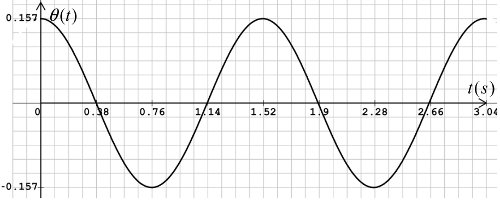
Exercice 3: Radioactivité et propagation des ondes
3.1. Radioactivité:
3.1.1 a) Ecrivons l’équation générale de la réaction globale.
\({}_{92}^{238}U \to \) \({}_{82}^{206}Pb + x{}_2^4He + y{}_{ - 1}^0e\)
3.1.1.b ) calcule x et y.
D’après la loi de Soddy, nous avons
\(\left\{ \begin{array}{l}238 = 206 + 4x\\92 = 82 + 2x - y\end{array} \right.\) \( \Rightarrow x = 8{\rm{ et }}y = 6\)
3.2.1 Déterminons le temps t qu’il faudra pour qu’elle soit divisée par 1500.
\(A(t) = {A_0}\exp ( - \lambda t)\) avec \(A(t) = \frac{{{A_0}}}{{1500}}\)
\(\frac{{{A_0}}}{{1500}}\) \( = {A_0}\exp ( - \lambda .t)\) \( \Rightarrow t = \frac{1}{\lambda }\ln 1500\) \( = \frac{T}{{\ln 2}}\ln 1500\)
\(\color{blue}{t = 73,85\min }\)
3.2. Propagation des ondes mécaniques
3.2.1. Calcule la célérité V des ondes.
\({\rm{V}} = \lambda .f = 0,308{\rm{m/s}}\)
3.2.2 Dessinons l’aspect de la surface libre de l’eau comprise entre les deux extrémités de la fourche.
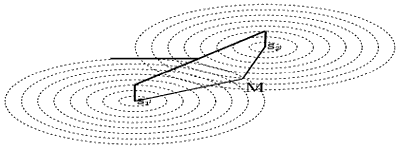
3.2.3 Les franges d’interférences se resserrent car, de la formule v=λf , si v reste constante, λ doit diminuer.
Exercice 4 Exploitation d’une fiche de T.P
5.1. Tracer la courbe x = f(t2)
| \({T^2}({s^2})\) | 0 | 4 | 14 | 36 | 42,25 |
| x (m) | 0 | 0,19 | 0,77 | 1,73 | 2,03 |
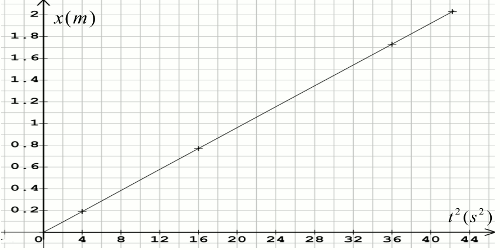 5.2 La courbe est une droite donc l’équation est de la forme: \(x(t) = a.{t^2}\)
5.2 La courbe est une droite donc l’équation est de la forme: \(x(t) = a.{t^2}\)5.3 justification
•Un fil étant inextensible de masse négligeable, la poulie étant également de masse négligeable
\({a_B} = {a_A}\) \( = r\ddot \theta = {a_G}\)
5.4 Montrons que l’accélération a commune de M et de M’ est de la forme: \({a_G} = \frac{m}{{2M + m}}g\)
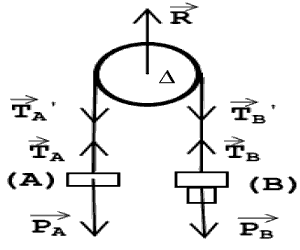
En effet: d’après le schéma nous avons, à partir du TCI:
Pour le solide (A)
\({\overrightarrow P _A} + {\overrightarrow T _A}\) \( = {m_A}{\overrightarrow a _G}\) \( \Leftrightarrow {\overrightarrow P _A}\left| \begin{array}{l}0\\ - {P_A}\end{array} \right.\) \( + {\overrightarrow T _A}\left| \begin{array}{l}0\\{T_A}\end{array} \right.\) \( = {m_A}{\overrightarrow a _G}\left| \begin{array}{l}0\\{a_G}\end{array} \right.\)
Soit : \( \color{blue}{- {P_A} + {T_A}}'\) \( \color{blue}{= {m_A}{a_G}}{\rm{ \color{red}{\ (1)}}}\)
Pour le solide (B)
\({\overrightarrow P _B} + {\overrightarrow T _B}\) \( = {m_B}{\overrightarrow a _G}\) \( \Leftrightarrow {\overrightarrow P _B}\left| \begin{array}{l}0\\{P_B}\end{array} \right.\) \( + {\overrightarrow T _B}\left| \begin{array}{l}0\\ - {T_B}\end{array} \right.\) \( = {m_B}{\overrightarrow a _G}\left| \begin{array}{l}0\\{a_G}\end{array} \right.\)
Soit : \({\color{blue}{P_B} - {T_B}}\) \(\color{blue}{ = {m_B}{a_G}}{\rm{\color{red}{\ (2)}}}\)
D’après le principe des actions réciproques
\({T_A} = {T_A}'\) et \({T_B} = {T_B}'\)
La masse de la poulie étant négligeable, nous avons:
\({\mathfrak{M}_\Delta }({T_A}')\) \( + {\mathfrak{M}_\Delta }({T_B}')\) \( = {J_\Delta }\ddot \theta = 0\)
\( - r{T_A}' + r{T_B}'\) \( = 0 \Rightarrow \)\({T_A}' = {T_B}'\)
Ainsi : \({T_A} = {T_B}\) \( = {m_B}.g - {m_B}{a_G}\) \( = {m_A}.g + {m_A}{a_G}\)
\({a_G} = \frac{{{m_B} - {m_A}}}{{{m_B} + {m_A}}}g\) \( = \frac{{M + m - M}}{{M + m + M}}g\) \( = \frac{m}{{m + 2M}}g\)
La loi horaire des ( A ) et ( B ) système est dont de la forme
\(x(t)\) \( = \frac{1}{2}.\frac{m}{{(m + 2M)}}g.{t^2}\)
- Déterminons la valeur expérimentale gexp de l’accélération de la pesanteur du lieu de l’expérience
De la droite précédente, nous avons la pente suivante:
\(p = \tan (\theta )\) \( = \frac{{\Delta x}}{{\Delta {t^2}}}\) \( = \frac{{2,03 - 0,2}}{{42,25 - 4}}\) \( = 47,85 \times {10^{ - 3}}\) \(g = \frac{{2p(m + 2M)}}{m}\) \(g = 9,667{\rm{N/kg}}\)


